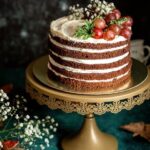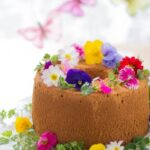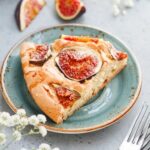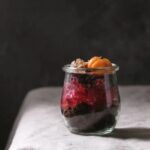Cake decorating has evolved over the years, and one technique that has gained significant popularity is airbrushing. Airbrushes provide a versatile and efficient way to add intricate designs and vibrant colors to cakes, creating stunning edible works of art.
But before diving into the world of airbrushing for cake decoration, it’s important to understand the fundamentals. This article will guide you through the basics of cake decorating with airbrushes, including the benefits of using an airbrush, factors to consider before starting, and an overview of key techniques.
Airbrushing has become increasingly popular in cake decorating due to its ability to achieve stunning and professional-looking results. By using an airbrush, decorators can effortlessly create smooth gradients, intricate patterns, and even realistic textures on cakes. The precision and control provided by an airbrush allow for incredible detail that would be nearly impossible with traditional methods such as piping or hand-painting.
There are several benefits to using an airbrush for cake decoration. Firstly, it saves time compared to other techniques as it covers large areas quickly and efficiently. Secondly, it allows for precise color application without smudging or streaks. Additionally, airbrushing provides a consistent thickness of color that can be easily adjusted according to preference. Whether you’re a beginner or an experienced decorator looking to enhance your skills, incorporating an airbrush into your toolbox opens up endless possibilities.
Before embarking on your journey into cake decorating with an airbrush, there are a few key factors to consider. Understanding the different types of airbrushes available in the market is essential in making the right choice for your specific needs.
Factors such as ease of use, functionality, maintenance requirements, and budget should all be taken into account when selecting an airbrush suitable for cake decorating. In addition to this, ensuring compatibility with food-safe materials is crucial as some conventional airbrushes may not be safe for use on edible items.
By following this comprehensive guide, you’ll be equipped with the knowledge needed to choose the right airbrush for your cake decorating needs and unleash your creativity. Whether you’re a novice looking to experiment or a professional seeking new techniques, airbrushing opens up a world of possibilities in cake decoration.
So, let’s delve into the different types of airbrushes, explore compatibility with food-safe materials, learn essential airbrushing techniques, and discover maintenance tips and safety precautions to ensure an enjoyable and successful experience.
Understanding Different Types of Airbrushes
When it comes to cake decorating with airbrushes, it is important to have a good understanding of the different types of airbrushes available in the market. Each type has its own set of features and functionality that can greatly impact the quality and ease of your cake decoration process.
Single-Action vs Dual-Action Airbrushes
One key distinction among airbrushes is whether they are single-action or dual-action. Single-action airbrushes have a simple mechanism where pressing down on the trigger releases both the air and paint simultaneously. This type is typically more affordable and easier to use, making it a popular choice for beginners or those looking for basic techniques.
On the other hand, dual-action airbrushes provide more control over both the airflow and paint flow. With a dual-action airbrush, pressing down on the trigger controls the airflow while pulling back on the trigger determines how much paint is released. This level of control allows for more intricate detailing and shading, making dual-action airbrushes preferred by experienced decorators.
Gravity-Feed vs Siphon-Feed Airbrushes
Another important factor to consider is whether you should go for a gravity-feed or siphon-feed airbrush. Gravity-feed airbrushes have a cup attached at the top which holds the paint. As gravity pulls down on the paint, it flows naturally into the nozzle when you press the trigger. This type is favored for its ability to work with small amounts of paint and facilitate quick color changes.
On the other hand, siphon-feed airbrushes have a bottle or jar below them that holds the paint. The pressure created by compressed airflow draws paint up into the nozzle when you pull back on the trigger. Siphon-feed airbrushes are known for their ability to hold larger amounts of paint without frequent refills, making them suitable for larger cake decorations or continuous use.
Pros and Cons
Each type of airbrush has its own pros and cons when it comes to cake decorating. Single-action airbrushes are easy to learn and tend to be more affordable, but they may not provide the same level of control and precision as dual-action airbrushes. Gravity-feed airbrushes are great for small, detailed work and allow for quick color changes, while siphon-feed airbrushes are ideal for larger projects but can be bulkier to handle.
Ultimately, the choice between different types of airbrushes will depend on your specific needs, preferences, and experience level in cake decorating. It is recommended to try out different models or consult with experienced decorators to determine which type would best suit your requirements.
By understanding the different types of airbrushes available in the market, you can make an informed decision about which one is most suitable for your cake decorating needs. In the next section, we will explore the compatibility of airbrushes with food-safe materials.
Compatibility of Airbrushes with Food-Safe Materials
When it comes to cake decorating, using airbrushes that are compatible with food-safe materials is crucial. The last thing you want is to compromise the safety of your edible creations. It is important to ensure that the airbrushes you use are specifically designed and certified as food-safe.
Using non-food safe airbrush materials can have serious health risks. Some airbrushes may contain lead or other harmful chemicals that can contaminate the food. This is why it is essential to thoroughly research and choose airbrushes that are designated for edible applications.
To determine if an airbrush is food-safe, look for certifications such as FDA approval or NSF International certification. These indicate that the materials used in the airbrush are safe for contact with food and will not leach any harmful substances.
| Brand | Certified Food-Safe Models |
|---|---|
| AirMaster | AirMaster Food-Safe Airbrush Pro Kit |
| Kopykake | Kopykake Airmaster CS Air Compressor Kit |
| Iwata | Iwata Eclipse HP-CS Dual Action Airbrush |
While these brands offer food-safe options, it is always recommended to read customer reviews and do further research before making a purchase.
By choosing airbrushes that are certified as food-safe, you can have peace of mind while working on your cake decorations and ensure the safety of those who will consume them. Investing in a quality airbrush designed for edible applications is an important step in achieving professional and safe results in cake decorating.
Airbrushing Techniques for Cake Decoration
Airbrushing is a versatile and effective technique that can take your cake decorating skills to the next level. Whether you want to create gradient effects, shading, or stenciled designs, an airbrush can be a valuable tool in your arsenal. In this section, we will introduce you to various airbrushing techniques that you can use for cake decoration.
- Creating Gradient Effects: One of the most popular techniques in airbrushing is creating smooth and seamless gradient effects on cakes. To achieve this, start by selecting two or more colors of edible airbrush paint that blend well together.
Hold the airbrush about 6-10 inches away from the cake surface and spray a light coat of the lighter color as a base. Then, gradually layer the darker color(s) starting from the bottom or top edge of the cake, making sure to blend them smoothly. - Shading: Airbrushing is perfect for adding depth and dimension to your cake designs through shading. To shade using an airbrush, choose a darker shade than your base color and lightly spray it along the edges or contours of your design elements. Gradually build up the intensity until you achieve the desired effect. This technique works particularly well for creating realistic-looking shadows on fondant decorations.
- Stenciled Designs: Stencils are a great way to add intricate patterns or images to your cakes without having to freehand them. Start by securing your stencil firmly onto the cake surface with tape or non-toxic adhesive. Then load your airbrush with edible paint and hold it perpendicular to the stencil opening.
Begin spraying lightly over the stencil, moving in even strokes until all areas are covered evenly. Carefully remove the stencil to reveal your beautifully stenciled design.
To further enhance your airbrushing skills, practice these techniques on spare pieces of fondant or sugar paste before attempting them on actual cakes. Additionally, keep in mind that the distance between the airbrush and the cake surface, as well as the pressure applied, will affect the intensity of colors and effects achieved. Experimenting and refining your techniques will help you achieve stunning airbrushed designs on your cakes.
Maintenance and Care for Airbrushes
Proper maintenance and care of airbrushes are essential for their longevity and optimal performance. Neglecting to clean and maintain your airbrush can lead to clogs, inconsistent spraying, and overall poor results in your cake decorating projects. In this section, we will discuss the importance of maintenance, provide step-by-step cleaning instructions, troubleshoot common issues, and recommend additional tools and accessories for airbrush care.
Cleaning an airbrush after each use is crucial to prevent the buildup of dried paint or food coloring that can clog the nozzle and impede proper airflow. Here is a step-by-step guide on how to clean your airbrush:
- Disassemble the airbrush: Start by removing the needle, nozzle cap, nozzle, and cup from the airbrush body according to the manufacturer’s instructions.
- Flush with water or cleaning solution: Use a cleaning solution specifically designed for airbrushes or plain water to flush out any remaining paint or food coloring. You can use a soft brush or toothbrush to gently scrub away any stubborn residue.
- Clean individual parts: Pay special attention to cleaning the needle and nozzle. Use a cotton swab or pipe cleaner soaked in cleaning solution to remove any dried paint or color particles.
- Reassemble the airbrush: Once all the parts are clean and dry, reassemble your airbrush carefully following the manufacturer’s instructions.
Troubleshooting common issues with airbrushes is also important for maintaining their functionality. Some common problems include uneven spray patterns, spattering or splattering of color, and inconsistent airflow. If you encounter any of these issues, here are some potential solutions:
- Uneven spray patterns: Check if there are any blockages in the nozzle or needle tip that could be causing uneven spraying. Clean them thoroughly using the above mentioned cleaning process.
- Spattering or splattering of color: This issue could be caused by a damaged or worn-out needle or nozzle. Inspect these parts and replace them if necessary.
- Inconsistent airflow: Check if there are any loose connections or clogged air passages that could be affecting the airflow. Tighten any loose fittings and clean out any obstructions in the air passages.
In addition to regular cleaning and troubleshooting, there are certain tools and accessories that can help in maintaining your airbrush. These include airbrush cleaning kits, lubricants for needle movement, spare parts such as needles and nozzles, and storage solutions to protect your airbrush when not in use.
Proper maintenance and care of your airbrush will not only extend its lifespan but also ensure consistent results in your cake decorating projects. By following the cleaning instructions, troubleshooting common issues, and investing in additional tools and accessories, you can keep your airbrush in excellent condition for years to come.
| Recommended Tools | Benefits |
|---|---|
| Airbrush cleaning kit | Includes all the necessary brushes, cleaners, and tools for thorough cleaning |
| Lubricant for needle movement | Keeps the needle moving smoothly for consistent spray patterns |
| Spare parts (needles, nozzles) | Allows for quick replacements in case of damage or wear-outs |
| Airbrush storage solution | Protects the airbrush from dust and damage when not in use |
Choosing the Right Airbrush for Your Cake Decorating Needs
When it comes to cake decorating with an airbrush, selecting the right airbrush is crucial to achieve desired results. There are several factors to consider when choosing an airbrush for cake decoration, including budget, skill level, and specific requirements. This section will guide you through the process of selecting the perfect airbrush for your cake decorating needs.
Factors to Consider When Selecting an Airbrush for Cake Decorating
Before making a purchase, it’s essential to evaluate your specific requirements and preferences. Firstly, consider your budget. Airbrushes can range from affordable options suitable for beginners to high-end models designed for professionals. Determine how much you are willing to spend and look for options within your price range.
Another crucial factor is your skill level and experience in cake decorating. Beginners may benefit from simpler airbrush models that are easy to use and handle. Intermediate bakers might want a more advanced airbrush that offers more control and versatility. Professionals may require a high-quality airbrush with additional features to achieve intricate designs.
It’s also important to consider the type of cakes you will be decorating. If you plan on working with larger cakes or need to cover a large surface area, opt for an airbrush with a bigger cup size or gravity-feed system, which allows continuous spraying without frequent refills. Conversely, smaller designs or detailed work might require an airbrush with finer control and precision.
Recommended Airbrush Models Suitable for Beginners, Intermediates, and Professionals
For beginners, popular choices include single-action airbrushes such as the Master Airbrush Model C16-B Black Mini Air Compressor. These simple yet reliable airbrushes come at an affordable price point and are easy to operate.
Intermediate cake decorators may find dual-action airbrushes like the VIVOHOME 110-120V Professional Precision Dual Action Gravity Feed Airbrush Kit more suitable. These models offer greater control with adjustable airflow and paint flow, allowing for more intricate designs.
Professional cake decorators who require top-notch performance might consider investing in premium airbrush models like the IWATA-MEDEA HP-CS Eclipse Airbrush Kit. These high-end airbrushes offer exceptional precision, durability, and advanced features needed to achieve complex designs.
Customer Reviews and Feedback on Popular Airbrush Brands for Cake Decoration
When choosing an airbrush, it’s always helpful to consider customer reviews and feedback on different brands and models. This can provide valuable insights into the reliability, performance, and longevity of various airbrushes. Online platforms such as Amazon or specialized cake decorating forums are excellent resources to read reviews from other cake decorators who have used specific airbrushes.
By carefully considering your budget, skill level, specific requirements, and reading customer reviews, you can make an informed decision when selecting the right airbrush for your cake decorating needs. Remember that every cake decorator is unique, so it’s important to find an airbrush that aligns with your individual style, preferences, and goals in order to create stunning cake designs.
Safety Precautions to Take When Airbrushing Cakes
When airbrushing cakes, it is essential to prioritize safety precautions to ensure a smooth and accident-free decorating experience. By following these guidelines, cake decorators can protect themselves and others from potential harm.
- Proper Ventilation: Adequate ventilation is crucial when working with airbrushes and food-safe colorings. The fumes from the colorings can be harmful if inhaled excessively. Therefore, it’s recommended to work in a well-ventilated area or use a fume extraction system to remove any airborne particles.
- Protective Gear: To protect your eyes from overspray and potential contamination, wearing goggles or safety glasses is strongly advised. Additionally, using a mask or respirator will prevent inhalation of any particles or fumes.
- Controlled Environment: Creating a controlled environment for airbrushing cakes is important for both safety and efficiency. It helps minimize distractions, reduce the chances of accidents, and ensures a clean workspace. Clear away any clutter and make sure there are no flammable materials nearby.
- Allergies and Health Risks: It’s important to be aware of any allergies you might have when working with food coloring or other airbrush materials. If you have sensitivities or respiratory conditions such as asthma, take extra precautions to avoid exposure or consult with a healthcare professional beforehand.
To enjoy the benefits of airbrushing while maintaining safety standards, follow these precautionary measures outlined above. By taking the necessary steps to protect yourself and others during the cake decorating process, you can continue exploring new techniques and creating stunning designs without compromising your well-being.
Frequently Asked Questions on Using Airbrushes for Cake Decorating
In conclusion, airbrushing has become a popular and versatile technique in the world of cake decorating. It offers numerous benefits, including the ability to create stunning designs, gradients, shading, and stenciled effects. However, when it comes to using an airbrush for cake decoration, certain factors need to be considered.
Understanding the different types of airbrushes is crucial in order to make an informed choice. Single-action and dual-action airbrushes each have their own advantages and disadvantages. Gravity-feed and siphon-feed airbrushes also have distinct qualities that may affect their suitability for cake decorating. It is important to research and choose an airbrush that fits your specific needs and preferences.
Another key consideration is the compatibility of airbrushes with food-safe materials. Using non-food-safe materials can pose health risks and should be avoided at all costs. Ensure that your airbrush is certified food-safe and follow proper guidelines for cleaning and maintenance to prevent any contamination.
In addition to proper maintenance, it is essential to practice safety precautions when using an airbrush for cake decorating. This includes working in a well-ventilated area, wearing protective gear such as goggles and masks, and taking steps to prevent accidents or injuries.
Overall, by following these guidelines and frequently asked questions on using airbrushes for cake decorating, you can enhance your skills as a decorator while ensuring the safety of both yourself and those enjoying your creations. With the right equipment, techniques, and knowledge at hand, you can achieve stunning results with airbrushing on your cakes.
Frequently Asked Questions
Can you use a regular airbrush for cake?
Yes, a regular airbrush can be used for cake decorating. However, it is important to note that not all airbrushes are the same or suitable for edible use. When using an airbrush for cakes, it is crucial to ensure that the airbrush and all its components are food-safe.
This means that it should be free from any chemicals or materials that could be harmful when in contact with food. It is advisable to invest in an airbrush specifically designed for cake decorating, as they often come with features tailored to this purpose.
Can an airbrush be used for cake decorating?
Absolutely! Airbrushing is a popular technique used in cake decorating to achieve stunning and professional-looking designs on cakes.
Using an airbrush allows decorators to create smooth gradients, intricate details, textures, and even realistic images on cakes. The versatility of an airbrush makes it a valuable tool that can be used to apply color evenly across large cake surfaces or for more intricate work like stenciling or shading.
Which airbrush is best for cake decorating?
There are several options available when it comes to choosing the best airbrush for cake decorating. One popular choice among cake decorators is a dual-action gravity-feed airbrush. These airbrushes allow for better control over airflow and paint flow, making them ideal for achieving fine details and precise coloring on cakes.
Another factor to consider when selecting an airbrush is ease of cleaning and maintenance since working with edible materials requires thorough sanitation between uses. Additionally, having interchangeable needle sizes can be advantageous as different designs may require varying levels of detail. Ultimately, the best airbrush for cake decorating will depend on individual preferences and specific project requirements.

Welcome to my blog about home and family. This blog is a place where I will share my thoughts, ideas, and experiences related to these important topics. I am a stay-at-home mom with two young children. I hope you enjoy reading it! and may find some helpful tips and ideas that will make your home and family life even better!





